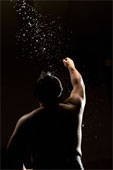It's about time I did a little kanji lesson here. I'm no expert at the Japanese pictographs, but I did learn a few, mostly names at the time, while I lived there. They say there are about 6,000 in total, but about 20 years ago there was a governmental decision to narrow down the number to 1500 that would be required in order for a person to be literate, to be able to read a newspaper. Now, in literature and in older texts, many more are necessary, but 1500-1800 is pretty much the minimum.
I know nowhere near that many. I think at my peak I probably picked up about 250. Most of those are long gone from the old bean. It's something that's easy enough to study, though, because flashcards are available at bookstores for a reasonable price and someone could learn several hundred pretty well with effort if they wanted to. After a while you can see patterns in the hen-scratches, and certain things are clues to what the general meaning of the kanji is. Like I say, I'm not really up to speed on that...I just want to throw out a few beginner kanji today.
Here's my favorite one.
This is "ichi." It's pronounced "ee-chee." It means "one." Two is similar. It's one line on top of this, but a little shorter. Pronounce it "ni." Three is three horizontal lines, and it's "san." Four changes, though.
The symbol for man (or person) is like this:
It's pronounced "hito" with the accent on the second syllable. I remember it because it looks like two legs, like a person walking or standing.
Another good beginning one is "chu," which means center. It's also pronounced, "naka." That's the thing, though. There are often more than one or two readings for a single symbol, so reading the exact word gets kind of tricky. Still, if you know what the symbol means generally, you can get the drift of the meaning of the word even if you don't know the exact way to say the word. Here's "chu."
Chu means "center" or middle. If it's followed by the kanji for "country" (read koku or goku) it is the first symbol for the name of the county of China. This always strikes me as interesting because Japan itself calls China the "center country." It refers to itself as "Nihon," which is made of the two symbols that mean "sun" and "origin." Here's "sun."
So, if Japan is the country where the origin of the sun is, it's the "country to the east" and they aren't technically the center of their own culture. Strikes me as interesting. So, that's why the term "land of the rising sun."
Just a few factoids and a few kanji today. I'll post more another time. There's also a specific order in which the strokes are performed, but again, it's a topic for another day. For now, I think I'll ponder whether or not I'm the center of my own world or not, or if I'm somewhere off to the east or west.






What a great post! Thank you for the information and greetings from Brazil. Just as a side note, my country is home to the largest japanese population outside of Japan. They have influenced our language, dietary habits and culture so it's always interesting to learn about them too. Cheers!
ReplyDeleteRafael-
ReplyDeleteGreat to hear from you! When I was in Japan I loved all the Brazilian Japanese people I met--lots of times at the English class I taught. Good times! Cheers right back at you!
--Hana